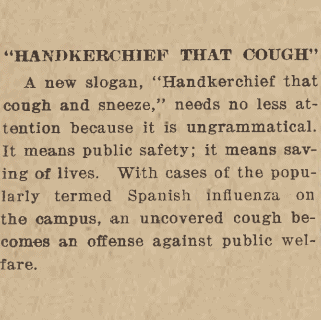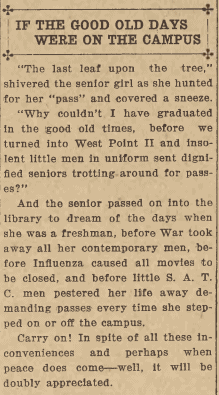In 1918 and 1919, the Spanish flu pandemic swept through Iowa killing over 6,000 people and infecting more than 93,000. The archives of the Daily Iowan from this time period shed light onto what life was like during that time on campus and in the midst of World War I. While cootie garments are mentioned in the April 14, 1918 Daily Iowan, the cootie garments were not meant as protection against the pandemic; they were made by women for the military to keep the soldiers free from bugs and pests in the trenches.
Articles about the Spanish flu are sprinkled throughout the Daily Iowan in the fall of 1918 during the second wave of the pandemic. The Oct 3, 1918 Daily Iowan says: ‘A slogan suggested by Dr. Henry Albert, state bacteriologist, will do much to check the disease. ‘‘Handkerchief that cough and sneeze” is his advice.’
Another part of the same issue reads: ‘A new slogan, “Handkerchief that cough and sneeze,” needs no less attention because it is ungrammatical. It means public safety; it means saving of lives. With cases of the popularly termed Spanish influenza on the campus, an uncovered cough becomes an offense against public welfare.’ The article also lists ways to stay safe given by Dr. John H. Hamilton, the state epidemiologist:
- “Avoid crowds or crowded places whenever possible.
- Do not place your hands or objects in your mouth unless you know they are clean.
- Keep in the best possible physical condition.
- Eat plenty of wholesome, easily digested food at regular intervals.
- Drink plenty of water—at least, eight or ten glasses a day.
- Take moderate outdoor exercise.
- Sleep in a well ventilated room.”
In the Oct 6, 1918 Daily Iowan, President Jessup issued regulations for the campus community to follow:
“1. All members of the University unit,—students, instructors and helpers, will be subjected to periodical health examinations.
2. Students will be directed to cover their mouths and noses with clean handkerchiefs or clean gauze when they sneeze or cough.
3. Instructors will report to the main office, University Hospital, telephone 70, the name of any student who neglects to so cover his mouth and nose when he coughs or sneezes.
4. Instructors will report to the main office of the University hospital, telephone 70, the name of any student whom they believe to be suffering from influenza, a cold, or any other disease.
5. The matrons of dormitories, sorority houses and rooming houses will report to the main office, University Hospital, telephone 70, the names of students who, on account of sickness, are unable to attend classes.”
The headline of the Oct 6 issue was “Iowa Defeats the Cornhuskers 12 to 0.” It was the first time the Hawkeyes had won a football game against Nebraska in 19 years.

On Oct 10, 1918: ‘“Everyone should avoid getting the feet wet during the rainy weather,” Dr. Henry Albert, state bacteriologist declares. Dampness causes the heat of the body to be lost readily and thus lowers the resistance. This not only favors the development of influenza, but tends to make the cases more severe and complicated, he states.”’
Another article in the Oct. 10th issue lamented the changes for students on campus due to the pandemic: ‘”The last leaf upon the tree,” shivered the senior girl as she hunted for her “pass” and covered a sneeze. “Why couldn’t I have graduated in the good old times, before we turned into West Point II and insolent little men in uniform sent dignified seniors trotting around for passes?”‘
Also, in the Oct. 10th issue, an article stated that nasal sprays were harmful “and may result in very serious operative cases” attributed in part to Dr. H. J. Prentiss, head of the anatomy department. However, this was recanted in the Oct. 13th issue: “The Iowan was mistaken Thursday in quoting Dr. H. J. Prentiss to the effect that the use of atomizers and especially nasal sprays drives influenza germs into the sinuses and may result in serious operative cases.”
One article in the Oct 13, 1918 issue of the Daily Iowan titled “Mental Influenza” proclaimed: “Worry is a waste, a disease. Some people worry over money and some people worry over the weather. Worry over influenza may be in the same class, that is, worry without any aim in view.”
A few days later, the Oct 15, 1918 an article in the Daily Iowan stated “Nurses at the University hospital are all working overtime and many are not taking their regular hours off duty. The day nurses begin duty at 7 a. m. and the night nurses at [illegible] p. m. Out of 135 nurses, 66 are ill and there are 22 probationers too ill for duty. All the probationers are helping and also the junior and senior medical students, dental students and S. A. T. C. men.” (S.A.T.C. stands for Student Army Training Corps; you can read about the history of the S.A.T.C. in an article that our University Archivist has written called “Old Gold: US and SUI enter World War I.”)
World War I ended on November 11, 1918, and the headline in the Daily Iowan on Nov. 12, 1918 was “University Celebrates Peace Holiday.”

The Dec. 3, 1918 Daily Iowan explains that after the university found 16 new cases of the flu, students were told to wear gauze masks and were not allowed to leave the city for around a week to 10 days in order to bring the pandemic under control. All campus activities were canceled, and the high school and elementary schools in Iowa City closed. Classes continued at the university and it was planned that the students would be able to go home for Christmas break. At that point, nearly 1200 students had been infected and were thought to be immune. Dec. 3rd is the final issue of the Daily Iowan for 1918 in the online archive.
In 2005, the Spanish flu was sequenced from the frozen remnants of a person who had died of it in 1918. The person’s remains were found in 1997 in Brevig Mission, Alaska (formerly called Teller Mission). The eight segments of the sequence can be viewed in GenBank. It was called the Spanish flu because it was first reported upon in a newspaper from Spain, but the origins of the Spanish flu remain unknown. The 1918 pandemic resulted in the death of 7 student nurses and thirty-one students at the University of Iowa. The complications of the Spanish flu, known now to be H1N1, were fluid-filled lungs and pneumonia. These severe health effects are thought to be due to the HA gene of the 1918 virus. When the HA gene was replaced with a different strain, lab mice lived rather than died when infected with the reconstituted 1918 H1N1 virus in a 2005 study by Tumpey et al.
If you are interested in learning more about the 1918 Spanish flu pandemic, you can view virtual exhibits at the National Archives and the National Museum of Health and Medicine, or check out materials from the UI Libraries. If you need help, contact a librarian at lib-sciences@uiowa.edu.







Pandemic 1918 : eyewitness accounts from the greatest medical holocaust in modern history
Flu : the story of the great influenza pandemic of 1918 and the search for the virus that caused it
Envisioning disease, gender, and war : women’s narratives of the 1918 influenza pandemic
Hunting the 1918 flu : one scientist’s search for a killer virus
Pale rider : the Spanish Flu of 1918 and how it changed the world
Fever of war : the influenza epidemic in the U.S. Army during World War I
The last Irish plague : the Great Flu Epidemic in Ireland 1918-19


